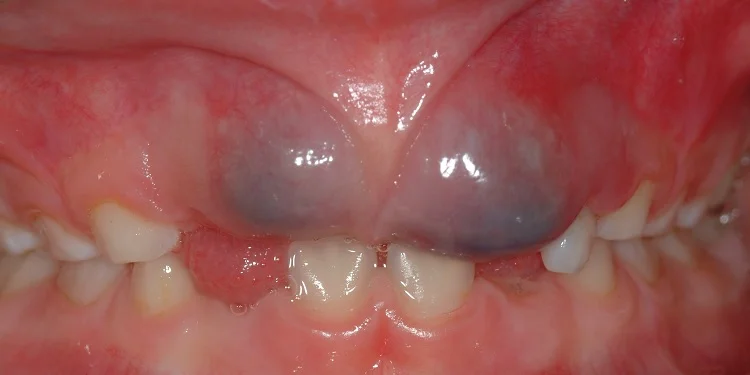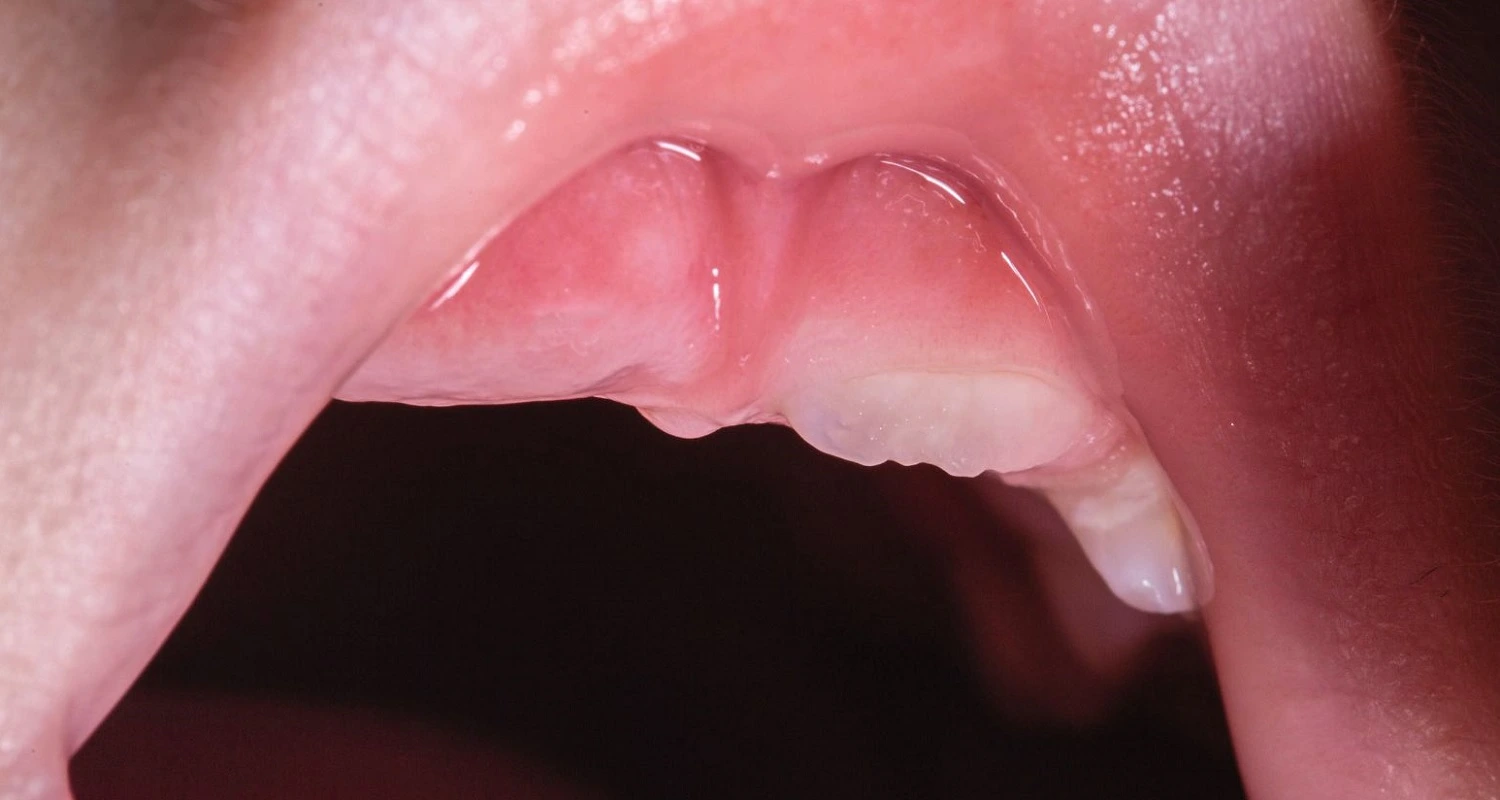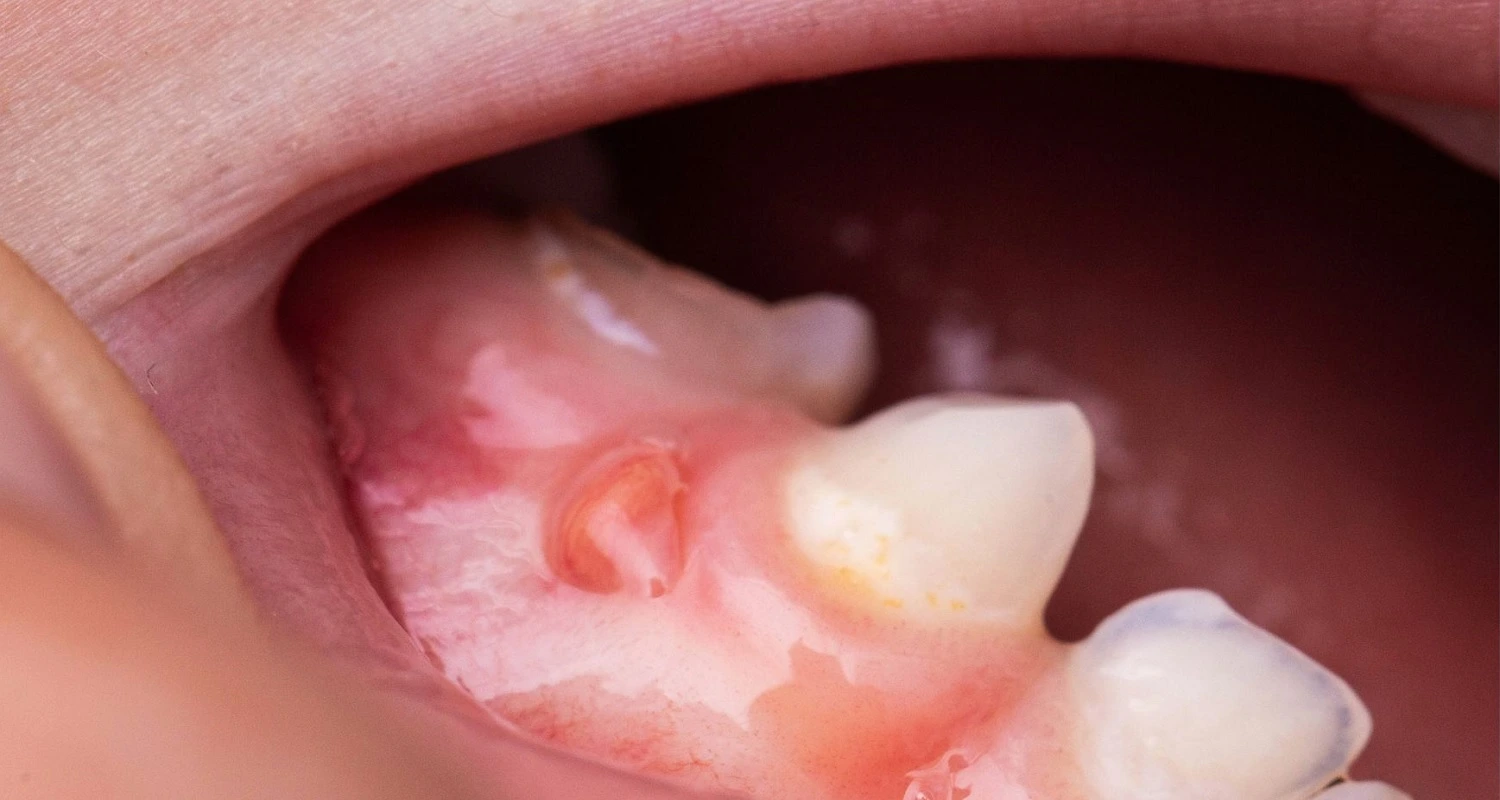Last Updated on: 30th December 2025, 08:05 am
What is an Eruption Cyst?
In the area where a new tooth should come out, a soft, fluid-filled bulge, which, although not painful, can be uncomfortable and unsightly. It is a possible eruption cyst.
Sometimes, parents take their children to a dental office worried about a very particular problem reason. The information about this injury will be expanded on below.
Eruption cysts are fluid-filled bags or sacs that form in the mucosa that cover a tooth that is about to erupt (come out of the gum).
Who can have an eruption cyst?
Because these lesions are associated with tooth eruption, they rarely occur in adults. They can happen during the eruption of temporary or permanent teeth. They are more frequent in the lower jaw and most cases usually occur in children, and men, especially between 6 and 9 years of age. However, although less common, babies can also suffer from rash cysts. In rare situations, babies present with eruptive cysts at birth or in the days following birth, due to the eruption of neonatal teeth. Neonatal teeth are designated as those that have erupted in the days close to birth and may be part of the group of temporary teeth that emerge before their time or additional teeth to the normal number.
What does an eruption cyst look like?
They are fluctuating (soft) lesions, transparent or bluish, that form in the soft tissue covering the tooth before its eruption. They are identified when they appear in a space where a new tooth should be located. The color of the cyst varies, depending upon whether it contains blood since when there is blood inside it, it can appear dark or bluish.
Do eruption cysts hurt?
Most rash cysts do not hurt. Parents are often alarmed and consult a dentist about the aesthetics, and because they have noticed the absence of the tooth for a long time. Only in some patients will there be pain or discomfort when biting or palpating the cyst, which is usually due to trauma or infection in the area.
What is the cause of an eruption cyst?
The specific origin of eruptive cysts is not yet clear, but it is believed that children with early childhood caries, trauma, infections in deciduous teeth, or insufficient space for the new tooth to erupt are prone to eruptive cysts.
Can eruption cysts be prevented?
As stated above, the causes of the cyst rash are still not clear; therefore, they are not preventable. However, to avoid alterations in the eruption of the teeth and reduce the possibility of the new teeth being affected, it is wise to protect the child from blows and infections.
What happens if a cyst from the eruption is not removed?
In most cases, these cysts are solved after a few weeks when the new tooth comes out, without the need for intervention by a dentist. However, if the cyst presents an infection and it is not treated, intense pain could occur, in addition to the risk of spreading it.
What to do before an eruption cyst?
• Avoid trauma: If possible, the patient’s diet should be soft, reducing the chances of further damaging the gum and causing pain.
• Go to the dentist before the warning signs: If the patient presents pain, fever, or general malaise, they should go to the dentist, who will indicate the most appropriate treatment for eruption cysts.
• Wait: Generally, after a few weeks the tooth erupts without a problem and the cyst disappears. If after 3 months the tooth does not come out even if the cyst disappears, it is necessary to go to a dentist.
What is the treatment for eruption cyst?
In cases where the cysts require intervention, the dental procedure is usually quite simple and minimally invasive. On our website, you will find articles that expand the information on the treatment of dentigerous cysts.
Frequently Asked Questions
What is an eruption cyst?
An eruption cyst is a fluid-filled sac that forms in the mucosa covering a tooth that is about to erupt through the gum.
Are eruption cysts developmental in origin?
Yes, eruption cysts are associated with the development and eruption of teeth, primarily occurring during the eruption of temporary or permanent teeth in children.
What do eruption cysts look like?
Eruption cysts are soft, transparent or bluish lesions that form in the soft tissue over a tooth about to erupt. If the cyst contains blood, it may appear dark or bluish.
What causes tooth eruption cysts?
The exact cause of eruption cysts is unclear, but they may be linked to early childhood caries, trauma, infections in deciduous teeth, or insufficient space for the new tooth to erupt.
What to do before an eruption cyst?
Avoid trauma by providing a soft diet to reduce gum damage and pain. Visit the dentist if there are warning signs like pain, fever, or general malaise. Generally, the cyst will resolve on its own as the tooth erupts, but if the tooth has not emerged after three months, a dental visit is necessary.
Share:
References
1. Specialists, D. I. (Nov 16, 2022). Eruption Cysts | What You Need To Know. Dental Implant & Specialist Centre. https://goldcoastimplantspecialist.com.au/news/eruption-cysts-what-you-need-to-know/
2. Şen-Tunç, E., Acikel, H., Sonmez, I. S., Bayrak, S., & Tüloğlu, N. (Mar, 2017). Eruption cysts: A series of 66 cases with clinical features.Oral medicine, oral pathology and oral surgery, 22(2), e228–e232. https://doi.org/10.4317/medoral.21499
3. Nagaveni, N. B., Umashankara, K. V., Radhika, N. B., & Maj Satisha, T. S. (Ene, 2011). Eruption cyst: a literature review and four case reports. Indian journal of dental research : official publication of Indian Society for Dental Research, 22(1), 148–151.
4. Council, O. (2015). Guideline on management considerations for pediatric oral surgery and oral pathology. Am Acad Pediatr Dent, 37(6), 279-288.
5. de Oliveira, A. J., Silveira, M. L., Duarte, D. A., & Diniz, M. B. (Ene, 2018). Eruption Cyst in the Neonate. International journal of clinical pediatric dentistry, 11(1), 58–60. https://doi.org/10.5005/jp-journals-10005-1485
6. Bilodeau, E. A., & Hunter, K. D. (Mar 15, 2021). Odontogenic and Developmental Oral Lesions in Pediatric Patients. Head and neck pathology, 15(1), 71–84. https://doi.org/10.1007/s12105-020-01284-3
7. Vega Llauradó, A., Ayuso Montero, R., Teixidor Olmo, I., Salas Enric, J., Marí Roig, A., & López López, J.. (Apr, 2013). Therapeutic options in odontogenic cysts: Review.Advances in Odontostomatology, 29(2), 81-93. http://scielo.isciii.es/scielo.php?script=sci_arttext&pid=S0213-12852013000200004&lng=es&tlng=es.
-
Nayibe Cubillos M. [Author]
Pharmaceutical Chemestry |Pharmaceutical Process Management | Pharmaceutical Care | Pharmaceutical Services Audit | Pharmaceutical Services Process Consulting | Content Project Manager | SEO Knowledge | Content Writer | Leadership | Scrum Master
View all posts
A healthcare writer with a solid background in pharmaceutical chemistry and a thorough understanding of Colombian regulatory processes and comprehensive sector management, she has significant experience coordinating and leading multidisciplina...

















